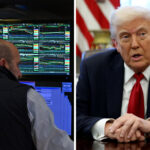
Navigating the Stock Market: Insights on CoreWeave, Canada Goose, Tesla, and United Airlines
Tháng 3 31, 2025
Navigating Peak Uncertainty: How Trump’s Tariffs Impact Markets
Tháng 3 31, 2025Hedge Funds Shift to Defensive Strategies Amid Economic Uncertainty
Recent developments in the financial markets indicate a significant shift in the investment landscape, particularly among hedge funds. As economic uncertainty looms, largely fueled by tariff-related volatility, hedge funds are increasingly adopting more defensive strategies. This strategic pivot reflects a broader trend of prioritizing risk management over aggressive growth, which is essential in navigating today’s tumultuous economic environment. As discussed in a blog on value investing, the importance of risk management aligns closely with hedge fund strategies during such times.
The Rise of Defensive Strategies
One of the most notable trends emerging from recent reports is the marked reduction of hedge funds’ exposure to risky assets, with a particular focus on technology stocks. As geopolitical tensions escalate and tariff uncertainties abound, hedge funds are recalibrating their portfolios to better weather potential market downturns. The intent behind these defensive strategies is clear: mitigate potential losses that could arise in volatile market conditions. By moving away from high-risk investments, these funds aim to secure their assets against unforeseen economic shocks.
Moreover, a resurgence of volatility across global markets has compelled hedge funds to exercise heightened caution. Emphasizing a more risk-averse approach, they value stability and preservation of capital as paramount objectives during this period of increased market instability. This shift is reinforced by insights shared in a blog addressing common investment mistakes, highlighting the significance of sound decision-making in volatile markets.
The Impact of Tariffs on Investment Decisions
The ongoing tariff threats, particularly those stemming from policies enacted during the Trump administration, have contributed significantly to the overall economic uncertainty. The unpredictability of trade relations has resulted in a fraught market environment, where even seasoned investors are challenged to find viable strategies. In response, hedge funds have adopted a dual approach: they are engaging in “buy the dip” strategies, particularly in cyclical stocks, while maintaining a prudent view towards defensive sectors.
Yet, this balancing act is complex; cautionary measures must still be adhered to when selecting investments. This notion echoes the ideas presented in another blog that outlines common investment mistakes, which stresses disciplined decision-making amidst market instability. Evidently, the mantra of being ‘selectively aggressive’ has taken precedence as hedge funds strive to navigate these choppy economic waters without exposing themselves to unmanageable risks.
Selling Tech Stocks: A Tactical Withdrawal
A defining characteristic of this current hedge fund strategy shift is the tangible withdrawal from tech stocks, which include some of the most prominent names in the market, such as Nvidia and Tesla. Recent reports indicate a slowdown in momentum strategies that typically favor technology sector investments. This decline is attributed to a parallel decrease in share values of these leading tech companies, prompting hedge funds to sell them off at an accelerated rate to rebalance their portfolios.
The rapid pace of these sell-offs underscores a broader trend of market sentiment turning against high-growth tech investments. As hedge funds reassess their holdings in light of recent volatility, their commitment to reweighting their portfolios illustrates a strategic maneuver aimed at stabilizing returns amid uncertainties of fluctuating asset values.
Exploring Alternative Investments
With the landscape of traditional investing shifting, hedge funds and their investors are increasingly casting their nets wider to explore alternative investment options. Notably, Treasury Inflation-Protected Securities (TIPS), international stocks, and real assets have gained traction as viable alternatives for diversifying portfolios. These investment vehicles not only serve as a hedge against inflation but also provide more conventional security in contrast to the increasingly unpredictable equity markets. This approach mirrors defensive strategies highlighted in a blog related to China’s investment moves, as it reflects a consideration for geopolitical risks.
In conclusion, as economic instability continues to guide the hedge fund space, the prioritization of risk management remains at the forefront of strategic decision-making. With defensive strategies now taking precedence over aggressive growth tactics, investors and fund managers alike must remain vigilant, continually adapting to the ever-evolving market dynamics.

